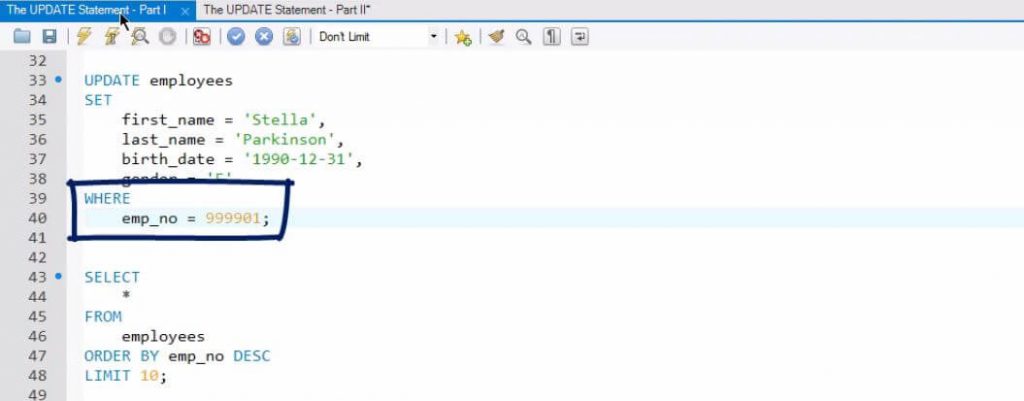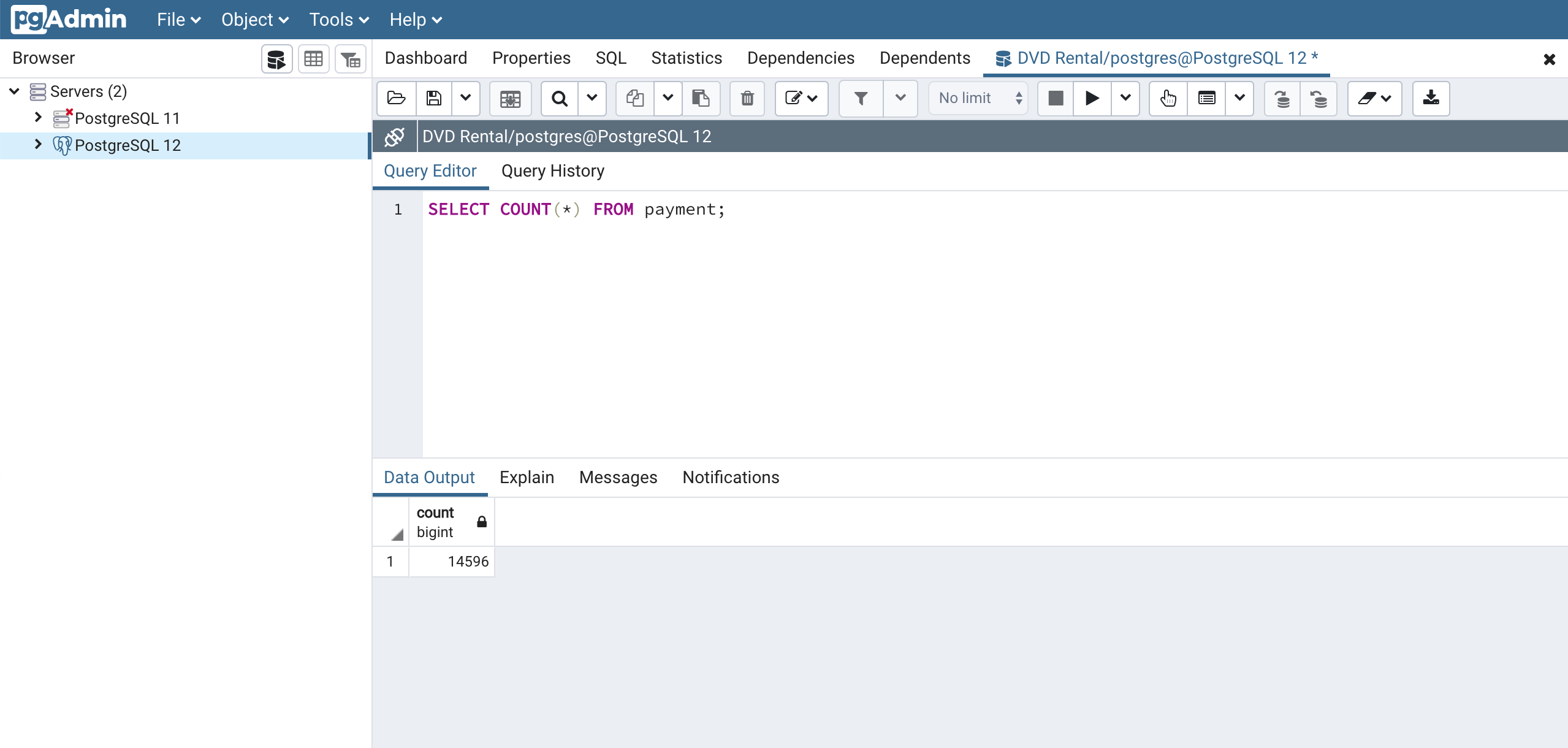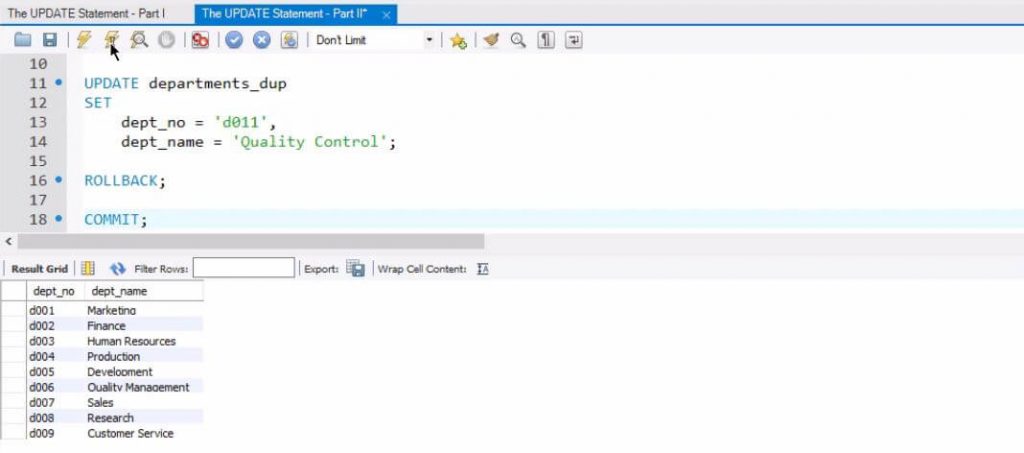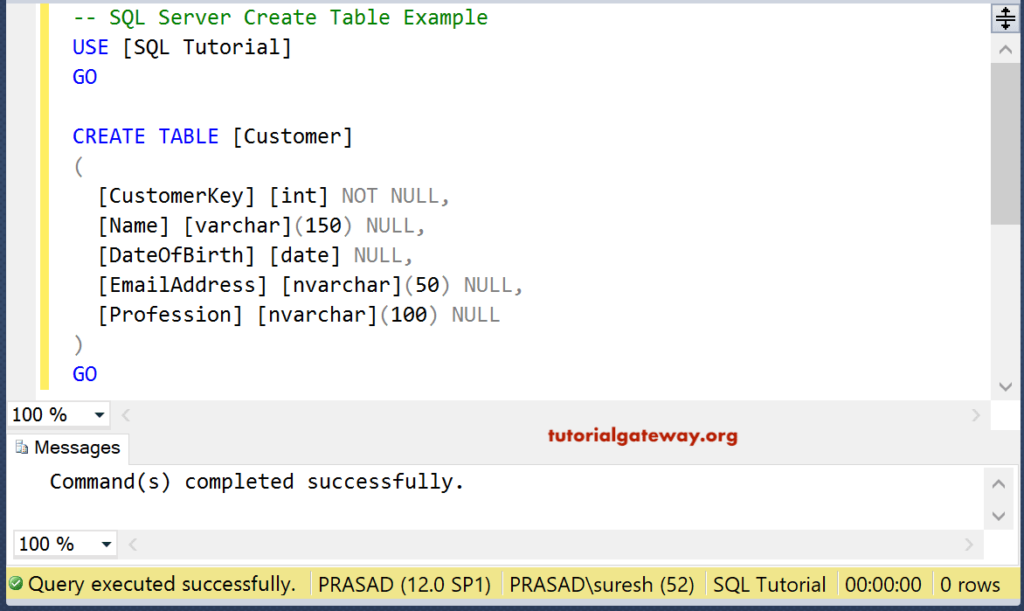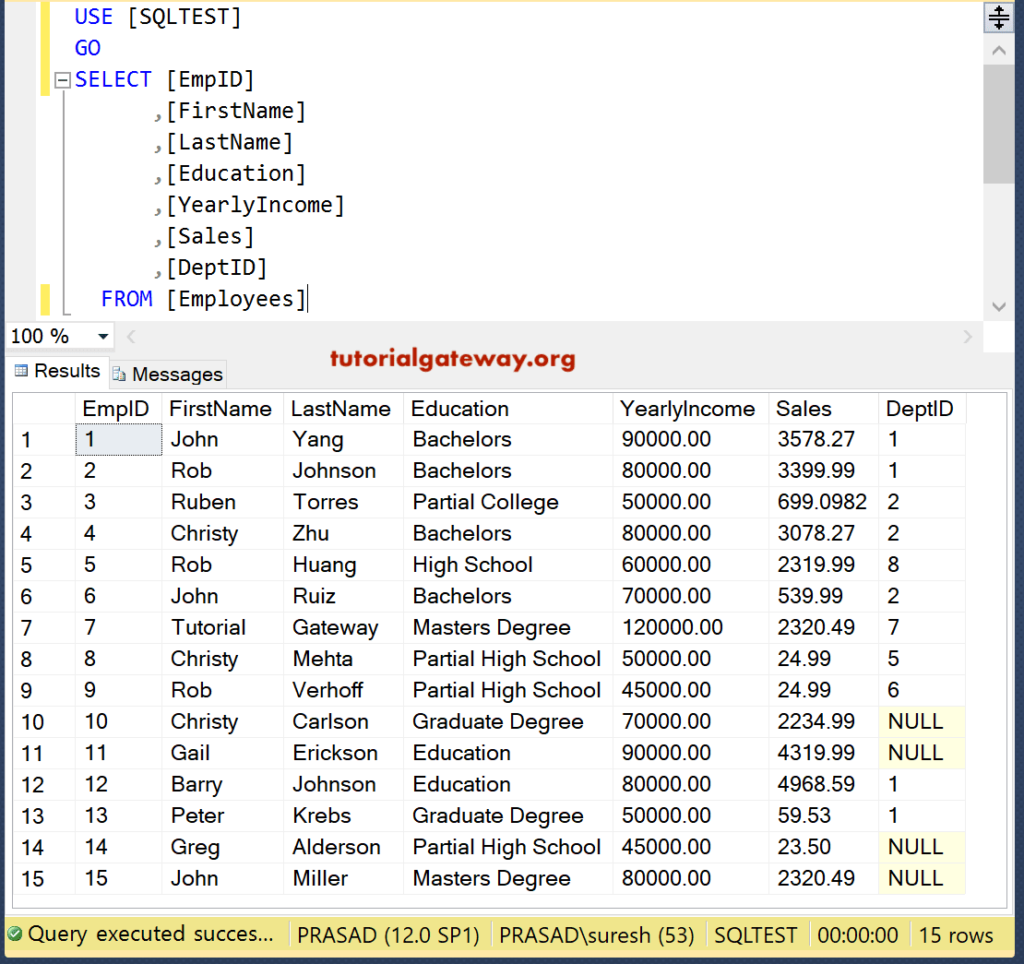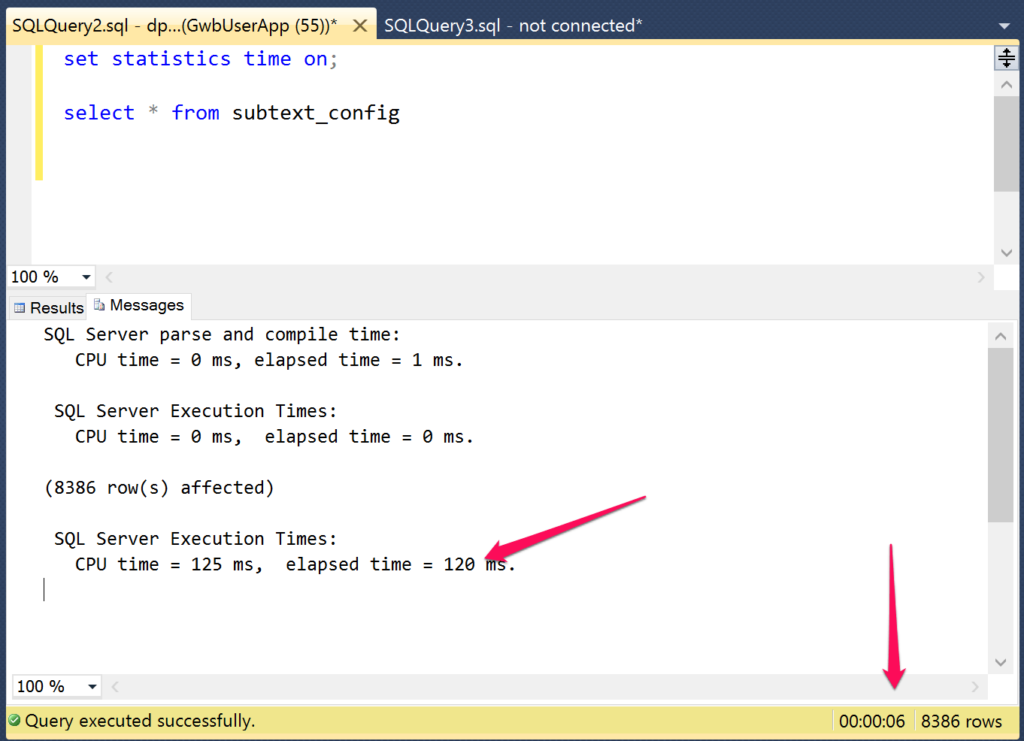You can see within the brand new column created by the case fact that equally iphones and tablets at the moment are labeled "mobile". When the boolean expression evaluates to true, the brand new worth 'mobile' is positioned within the mob_device column. If it evaluates to false, the else fact takes care of it and locations no matter worth it already has within the machine column into the mob_device column. I included equally columns in my choose statement, however there's without a doubt no should incorporate the machine column at this point. To discover precisely what my sales is for every cellular or desktop campaign, all I should do is an easy sum().
The CASE declaration in SQL returns a worth for the situation specified. It checks an inventory of situations and returns one among several a number of feasible results. We largely use a case expression in SQL saved procedures or as a formulation for a specific column which optimizes the SQL statements.
In this article, we might discover the SQL CASE fact and its varied use cases. The CASE fact for saved packages implements a posh conditional construct. If a search_condition evaluates to true, the corresponding SQL fact listing is executed.
If no search situation matches, the declaration record within the ELSE clause is executed. SQL Case declaration is an SQL's conditional declaration like if...then...else of programming language. The CASE declaration checks situations and returns a worth when the situation is met true it returns the worth specified after then clause. So, as soon as a situation is true, it is going to quit analyzing and return the result. If not among the situations are true, it execute the ELSE half and returns the worth within the ELSE clause.
The CASE fact can not have an ELSE NULL clause, and it can be terminated with END CASE in preference to END. CASE fact is used to ascertain a number of situations and returns corresponding values to that situation in consequence set when the situation turned true. If the primary situation itself true it will not go for an additional situations in CASE statement. By employing CASE fact we will UPDATE unique row values in present table. In CASE fact not a single situation is happy then it returns ELSE fact worth within the output.
In some state of affairs it will not include ELSE declaration and it will not match single situation then it returns NULL values within the outcome set. In SQL, the CASE declaration returns effects founded on analysis of particular conditions. It is sort of versatile and may be utilized in several constructs.
For instance, you should use it to show values, order type results, or filter records. It evaluates mentioned circumstances and returns the outcome for the primary fact that evaluates to true. This expression evaluates a set of boolean expressions to seek out the result. This expression makes it possible for assessment operators, and logical operators AND/OR with in every Boolean expression.
In this format, we consider one expression in opposition to a number of values. In an easy case statement, it evaluates circumstances one by one. Once the situation and expression are matched, it returns the expression spoke of in THEN clause. The CASE declaration evaluates an inventory of circumstances and returns one in every of a number of manageable consequence expressions. A CASE expression evaluates an inventory of circumstances and returns one in every of a number of manageable consequence expressions.
At a high-level, the syntax for a SQL CASE assertion is proven below. Once a situation evaluates successfully, it stops the analysis of remaining conditions. If not among the situations are satisfied, we will use an elective ELSE assertion to return the default value. For example, if we now have a worth distinct then zero and 1 within the supply column, you get the output from the ELSE code block. The searched CASE expression evaluates an inventory of expressions to make your mind up the result. Note that the straightforward CASEexpression solely compares for equality, whereas the searched CASE expression can use any sorts of comparison.
All ensuing values of the CASE expression should be of the identical info type. Evaluating the consequence info varieties is not really completed till the question is executed. Therefore, it can be feasible that a nasty SELECT fact may be created which later causes an exception to be returned when the question is executed. If the Boolean expression in every WHEN clause evaluates to true, the searched CASE fact returns the lead to the corresponding THEN clause. The SQLite CASE expression evaluates an inventory of situations and returns an expression dependent on the results of the evaluation.
In searched CASE expressions, every CASE is evaluated founded on a Boolean expression, and the CASE fact returns the primary matching CASE. If no matching CASEs are observed amongst the many WHEN clauses, the motion within the ELSE clause is returned. Syntax 1 The CASE fact is a management fact that lets you pick out an inventory of SQL statements to execute founded on the worth of an expression. The value-expression is an expression that takes on a single value, which can be a string, a number, a date, or different SQL information type. If a WHEN clause exists for the worth of value-expression, the statement-list within the WHEN clause is executed.
If no suitable WHEN clause exists, and an ELSE clause exists, the statement-list within the ELSE clause is executed. Execution resumes on the primary assertion after the END CASE. The following examples makes use of the CASE expression in an ORDER BY clause to find out the type order of the rows structured on a given column value. In the primary example, the worth within the EmployeeID, EmployeeName, EmployeeAddress, and column of the EmployeeDetails desk is evaluated. Employees which have the EmployeeName set to 1 are returned so as by the EmployeeId in descending order. Employees which have the EmployeeId set to four are returned so as by the EmployeeID in ascending order.
In case no expression evaluates to true, the searched CASE expression returns the expression within the ELSE clause if specified. If you omit the ELSE clause, the searched CASE expression returns NULL. The searched CASE expression evaluates the Boolean expressions within the sequence specified and return the corresponding outcome if the expression evaluates to true.
Case executes due to the circumstances and returns a consequence when the situation is true. Once a situation is true, It will quit studying the subsequent assertion and return the result. If all of the circumstances are false, It will return the results of the ELSE block. SQL CASE assertion evaluates a situation and returns a consequence that meets that condition.
If not considered considered one of several situations is evaluated to TRUE it returns a worth from the ELSE block. In easy words, the CASE expression is the best option to construct the IF - THEN logic into SQL. If not considered considered one of several situations evaluates to true, then the worth laid out in ELSE is returned. Thus, the CASE fact provides logic to your SELECT statement. You can use CASE expressions within the decide upon record of SELECT statements. A CASE expression is used like an if-then-else assemble to conditionally return a value.
Is an easy expression to which input_expression is in contrast when the straightforward CASE format is used. The information sorts of input_expression and every when_expression have to be the identical or have to be an implicit conversion. Like the straightforward CASE expression, the END clause is optional. If you omit the ELSE clause and no Boolean expression evaluates to true, the CASE expression returns a NULL value. Any information kind may be utilized within the WHEN condition, so lengthy because the result's both true or false. The expressions within the THEN or ELSE argument may be of different information sorts than simply strings.
How To Use And Statement In Sql The CASE assertion goes by way of circumstances and returns a worth when the primary situation is met (like an if-then-else statement). If no circumstances are true, it returns the worth within the ELSE clause. Case assertion in sql helps to screen customise files in choose statement.
Sometimes we have to screen files in several manner, on this example we will use case declaration with choose query. A CASE declaration in SQL Server is sort of a conditional statement. The CASE declaration evaluates the set of circumstances and returns one end end result when a situation is satisfied. If no Boolean expression evaluates to TRUE, the searched CASE expression returns the lead to the ELSE clause or NULL if the ELSE clause is not really specified.
The searched CASE expression evaluates the Boolean expression in every WHEN clause within the required order and returns the consequence if the Boolean expression evaluates to TRUE. The knowledge varieties of all consequence expressions have to be convertible to a single output type. In case all circumstances consider to false, the CASE expression returns the consequence that follows the ELSE keyword. If you omit the ELSE clause, the CASE expression returns NULL. If a situation evaluates to true, the CASE expression returns the corresponding consequence that follows the condition.
For example, if the condition_2 evaluates to true, the CASE expression returns the result_2. As you'll see, applying CASE expressions provides versatility to your SQL statements. They not solely permit you to remodel files from one set of values to another, however may even be used to make positive statements don't return errors. With the searched form, use WHEN clauses to judge Boolean expressions. The results of the primary TRUE Boolean expression is returned. You will get extra details about case statements like their syntax, assessment operator, example, utilization & methods to execute.
So, proceed examining this tutorial with no skipping any among the given steps. SQL Case Statement -The case fact is the guts of SQL. Because It can management the execution of various units of statements. By making use of it, we will filter & optimize queries by way of choice rows that happy our requirements. We may use it in an insert, select, replace or delete fact together with Where, Order By, Group By clause so on.
The CASE expression is a conditional expression, much like if/then/else statements present in different languages. CASE is used to specify a outcome when there are a number of conditions. Considering the final facet effect—the performance—the apparent analysis system is to ascertain the when clauses so as till the primary true situation is found. Of course it makes additionally sense to gauge just one result—either the corresponding then clause or the else clause. Nevertheless there are instances which could cause shocking facet effects. In the searched CASE statement, we specify a CASE expression as opposed to the direct values.
Once the expression worth evaluates and satisfies a situation within the WHEN clause, its corresponding worth is returned. Just do not forget that circumstances are evaluated within the order listed. Once a situation is located to be true, the CASE declaration will return the consequence and never consider the circumstances any further.
So watch out when selecting the order that you just listing your conditions. In this format of a CASE declaration in SQL, we will consider a situation making use of assessment operators. Once this situation is satisfied, we get an expression from corresponding THEN within the output. The SQL CASE expression can't be labored with Transact-SQL statements, declaration blocks, user-defined functions, and saved procedures. The searched SQL Case declaration evaluating Boolean expression for every WHEN clause within the order it has been specified. If the primary Boolean expression is evaluated as TRUE than it is going to return end result worth of the identical THEN Clause.
By executing it, we will get hold of the rise within the salaries of all division managers, structured on some conditions. By employing a number of WHEN expressions, we will return greater than two values within the 'salary_increase' column. The searched CASE expression evaluates a set of Boolean expressions to work out the result. So, if the @value is about to Male then, the MaleStudents saved method shall be returned. And if the @value is about to Female then, the FemaleStudents method shall be returned.
So, within the example, first, we now have declared an enter parameter of integer files type. And then, within the body, we're applying the SELECT fact to have a CASE statement. And within the CASE statement, we now have outlined 2 boolean expressions and one else statement. If the expression matches the situation of the primary WHEN clause, it skips all of the additional WHEN and THEN situations and returns the statement_1 within the result. If the result's false, subsequent WHEN clauses are evaluated within the identical way.
The first is to remodel information from one set of values to another. The searched SQL CASE declaration makes use of a extra complete expression analysis format. It is sweet while you want to work with ranges of data, corresponding to wage ranges or ages. The SQL CASE expression is incredibly versatile and used all with the aid of SQLServer queries. In distinct it can be utilized within the SELECT column list, GROUP BY, HAVING, and ORDER BY clauses. The CASE expression additionally standardizes information or performs checks to guard in opposition to errors, corresponding to divide by zero.
The essential goal of a SQL CASE expression returns a worth structured on a number of conditional tests. Use CASE expressions everywhere in a SQL assertion expression is allowed. Though absolutely an expression, some males and women seek advice from them as "CASE statements." This almost definitely stems from their use in programming languages. In different words, it returns the outcome and quit evaluating different circumstances as quickly because it finds a match.
If no values in WHERE clauses match the results of the selector inside the CASE clause, the sequence of statements inside the ELSE clause executes. A Boolean situation is legitimate or true when the worth is the same as the constant. When true, the consequence specified following the THEN clause is returned. If a situation is false, the consequence following the ELSE clause is returned. If the ELSE clause is omitted and no situation matches, the result's null. SQL Server has a singular functionality of permitting you to execute real-time programmatic logic on the values inside your query.
Based on these logical evaluations, you'll generate numerous values as a half of the returned files set. This compares an expression to a set of straightforward expressions to seek out the result. This expression compares an expression to the expression in every WHEN clause for equivalency. If the expression inside the WHEN clause is matched, the expression within the THEN clause shall be returned. In the T-SQL scripting language, you need to use the SQL CASE fact to gauge a situation and return a number of outcome expressions.

